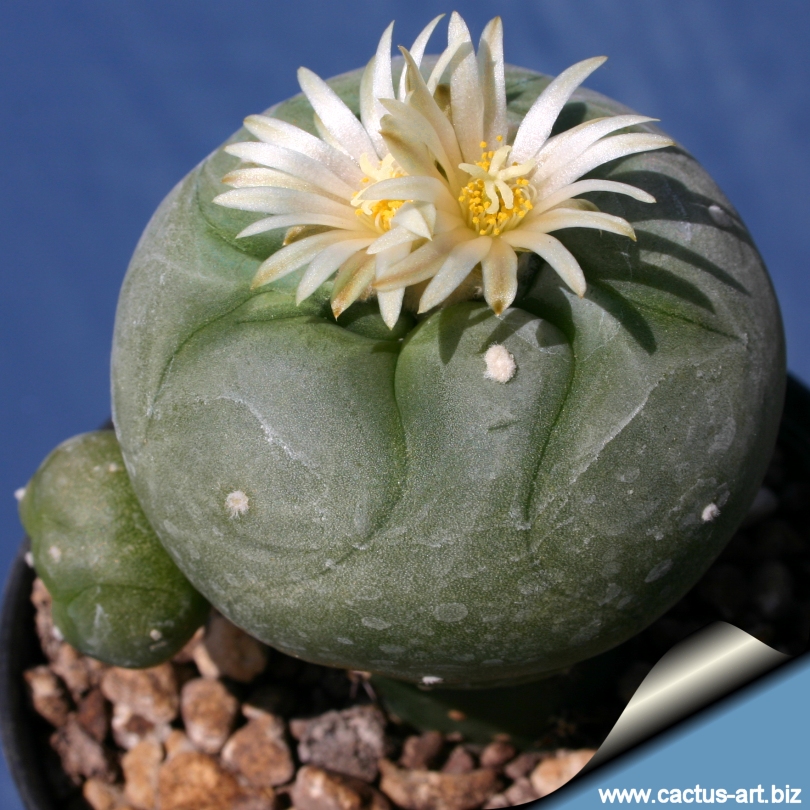|
|
|

Lophophora diffusa ssp.
kubesae
JJH 0010892 Punte Mezquitio , Queretaro, Mexico
This plant is prone to offsetting (in contrast to the typical
solitary stemmed L. diffusa specimens) eventually forming multi-headed
heaps up to 1,5 mt in diameter.
|
|
Description : The ssp. kubesai is
a globular spineless plant with a large tap root.
It is very similar in all aspects to the standard
L. diffusa,
and
is not easily distinguishable as a young plant..
The particularity of
this subspecies will be revealed only in older specimens that are larger
in size and tend to form large multi-headed heaps, up to 1,5 mt in
diameter (in contrast to the typical single stemmed L. diffusa
specimens).
Stem: Lacking well-defined ribs and furrows.
The epidermis is glaucous-yellow-grey..
Ribs: 5 to 13, the
podaria are are broad and flat.
Areoles: With tufts of hairs that usually spread unequally on the
scarcely prominent
podaria.
Flowers: The flowers are whitish or pinkish
(rarely red) , reaching over 3 centimetres in diameter. |
|
Cultivation: Slow growing.
It requires partial
shade in summer, full sun the rest of the year.
Grow it in a narrow and deep container to accommodate the tap root.
They
are very rot prone, so use highly gritty compost with much drainage.
Waterings should be rather infrequent, to keep the plant compact and
avoid it becoming excessively elongated and unnatural in appearance.
Watering it
properly is often difficult, because this plant tends to crack open or
rot if over-watered. The fact that the plant retracts into the soil and
assumes a grey-green colouring between waterings
is perfectly natural, and
doesn’t cause any damage.
Like other arid zone cacti, it requires a dry and cool over-wintering.
Otherwise they may succumb to rot.
This also promotes flowering.
Assure a
good ventilation.
Propagation: Seeds. Seeds
should be sown in spring in sterile cacti mix. Cover with a humidity
dome or plastic wrap and leave in a warm spot in 50-75% shade.
Fluctuating temperatures are best (ie. high daytime
temperatures and low night-time temperatures), as they simulate the desert environment.
Keep
constantly humid, as seedlings cannot survive if too dry.
Seedlings will
emerge in 7-21 days, and can be grown in the same environment for a
number of months. Mulch with
a thin layer of small quartz gravel (1-2
mm
in diameter). This helps them stay upright, hinders algae growth, and
regulates moisture. As they get older, the watering can become less
frequent. Potting up can be done when 5-10mm in diameter. |
|


Advertising
|
|
|
|
|
Family:
Cactaceae (Cactus
Family)
Scientific Name:
Lophophora diffusa
ssp. kubesae Halda, Kupcak et Malina ("kubesai").
in Actaa Mus Richnov. 9( 1): 66-67 & Fig.77. 2003
Halda. J. J. (2002) in Acta Mus. Richnov. 9(1): Fig.77 2003
Etymology: Named after the naturalist M. Kubesa,
friend of the author.
Common Name: False peyote. |
|
Origin: Endemic of the of the state of Querétaro, México
it grows only in a small area between Vizarron, Bucareli, and Toliman.
L. diffusa occurs at the southern end of the range of the genus.
Habitat: Xerophytic shrubland. L. diffusa grows mainly
beneath the canopy of some locally dominant shrubs and possible
nurse plants (e.g. Larrea tridentata and Acacia sororia)
Conservation status: Listed in
CITES appendix 2.
This is a relative of
Lophophora williamsii, the true Peyote. It has many
morphological and chemical differences, and does not contain the same
substances as L. williamsii. This species contains no
trace amounts of mescaline like the Peyote. But it does contain a lot of
other alkaloids, the principal of which is pellotine.
It is not narcotic and is not specifically named in the law, and
it is probably legal to possess.
|
Synonyms:
- Lophophora
diffusa (Croizat) Bravo
Published in: Cact. Succ. Mex. 12: 13, 1967
|
|
|
|

Lophophora diffusa ssp. kubesai |
|
Photo of conspecific
taxa, varieties, forms and cultivars of Lophophora diffusa.
|
|